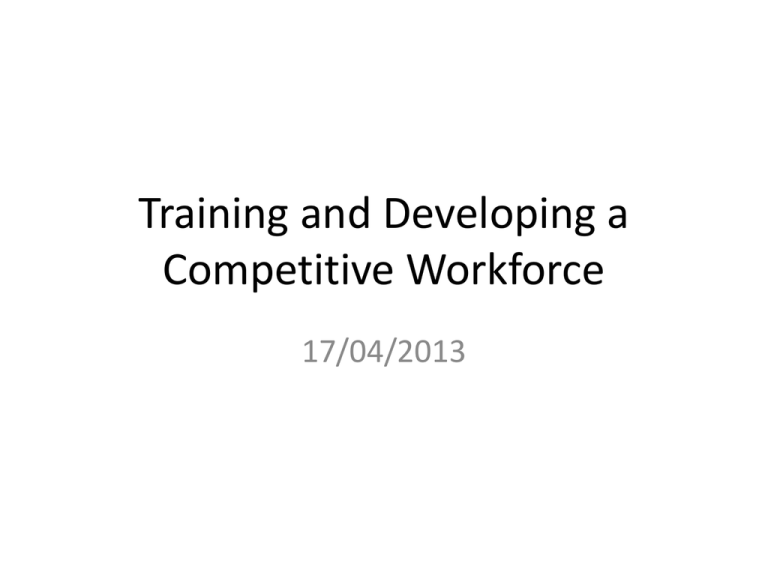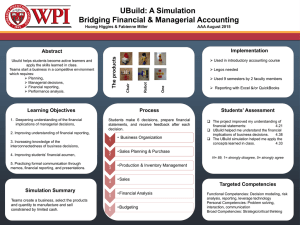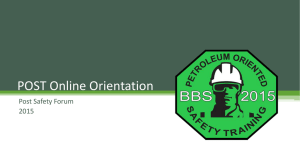Training and Developing a Competitive Workforce
advertisement

Training and Developing a Competitive Workforce 17/04/2013 Today’s sub-topics • 1. Strategic Importance of Training and Development • 2. Training and Development within an Integrated HR System • 3. The HR Triad • 4. Determining Training and Development Needs • 5. Conditions for Effective Training and Development Today’s sub-topics • • • • • • 6. Stating the Learning Objectives 7. Choosing the Program Format 8. Maximizing Learning 9. Team Training and Development 10. Current Issues 11. Videos 1. Strategic Importance of Training and Development • The use of training and development practices to improve the ability of the workforce to implement the organization’s business strategy • Development of organizational cohesiveness • Development of employee commitment • Address the employees’ needs in terms of their own competitive advantage and longterm employability 2. Training and Development within an Integrated HR System • Training, Development and Socialization - Training Its main objective is to improve performance in the near term and in a specific job by increasing the competencies of the employees - Development The activities intended to improve competencies over a longer period of time in anticipation of the organization’s future needs Training and Development within an Integrated HR System - Socialization Teaching the employees about the organization’s history, culture and management practices • Disney - Recruitment and selection It begins its socialization process during recruitment as a way to discourage applicants who may not fit the corporate culture … the ‘plastic smile’ 3. The HR Triad • Managers Acting as coaches, trainers, mentors • Employees By participating in training and development programs, they can facilitate their own socialization into the organization, potentially reaping longer-term benefits such as greater income, job satisfaction, better sense of personal identity • HR Professionals Identify the objectives to be achieved through training and development and then choose and design appropriate activities (given the objectives) 4. Determining Training and Development Needs • Organizational Needs Analysis It begins with an assessment of the short and long term strategy and strategic business objectives of the company • Job Needs Analysis (Or task) .. It identifies the specific skills, knowledge and behaviour needs to perform the tasks required by present or future jobs Determining Training and Development Needs • Person Needs Analysis It identifies gaps between a person’s current competencies and those identified as necessary or desirable • Demographic Needs Analysis It determines the training needs of specific ‘populations’ of workers 5. Conditions for Effective Training and Development • Personnel Decisions International (PDI) A large and successful HR consulting firm, developed a simple framework with 5 components 1. Insight – People need to know what it is they need to learn 2. Motivation – Internal / external means; will participation in training lead to positive benefits? Conditions for Effective Training and Development 3. New skills and knowledge acquisition – simply showing how to acquire the needed competencies 4. Real-world practice – programs that engage participants in realistic activities, improve the likelihood that they will apply their learning 5. Accountability – assessments of improvement and less formal approaches Conditions for Effective Training and Development • Who provides the required guidance? - Supervisors and other managers - A co-worker - Internal / external subject matter expert - The employee! → interpersonal, conceptual, integrative competencies … literacy and technical competencies … basic orientation sessions 6. Stating the Learning Objectives • Cognitive Knowledge The information that people have available (what they already know), the way they organize this information and their strategies for using it e.g. Company policies and practices – orientation programs brief new employees on benefit programs and options, advise them of rules and regulations and explain the policies and practices of the organization Stating the Learning Objectives • Skills Cognitive knowledge is inside the head, skills are evident in behaviors e.g. Interpersonal – skills in communication, team building, leadership, negotiation e.g. Technical – Six Sigma, a management process that is used for high-impact improvement efforts. Invented at Motorola in the 1980s, its main feature is statistical control techniques 7. Choosing the Program Format • On-the-job training When employees learn their jobs under direct supervision - Job rotation: rotating employees through jobs at a similar level of difficulty to train them in a variety of jobs and decision-making situations - Mentoring: an established employee guides the development of a less experienced worker Choosing the Program Format • Off-the-job training Appropriate when complex competencies need to be mastered or when employees need to focus on specific interpersonal competencies that might not be apparent in the normal work environment - Simulation: present situations that are similar to actual job conditions and allow trainees to practice how to behave in those situations - Formal courses: directed by the trainee or by others, formal classroom courses and lectures → Issue of transfer – can employees apply the knowledge learned during training? 8. Maximizing Learning • Setting the Stage for Learning - Clear instructions - Behavioral Modeling .. it involves describing the behaviors to be learned to trainees, having a role model provide a visual demonstration of the desired behavior, allowing the trainees to imitate the desired behaviors and give feedback • Increasing Learning during Training - Active participation, practice • Maintaining Performance after Training - Specific goals - Rein-forcers .. a consequence that follows behavior 9. Team Training and Development • E.g. NASA Training comes before effective teamwork .. Before astronauts are sent into space to live in a community that relies heavily on teamwork for survival, NASA has them working together for a year or two to become a team • Three main goals - Team cohesiveness - Teamwork procedures - Team leaders 10. Current Issues • Diversity Training - Culture Awareness Training Culture is the social group to which a person belongs .. and one person can belong in many and different social groups • Global Leadership Training and Development e.g. Intel .. with 91000 employees in 78 counties, it plans to invest $3 million to train 800 midlevel managers who are working across cultures 11. Videos • We will watch a couple of videos from youtube (titles and links will be given in class) and try and relate the issues raised in them to your experience at work - Do you feel performing better / ‘worse’ at work? - What are the reasons your level of performance?






